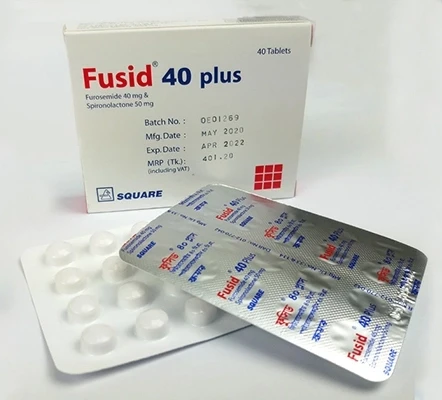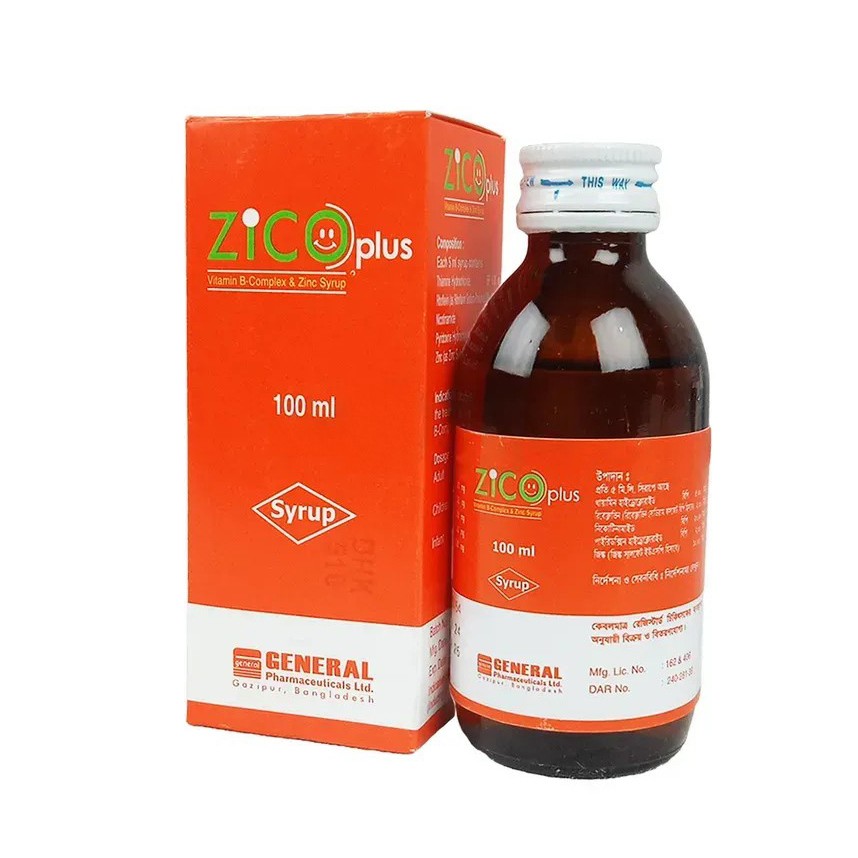

Fusid Plus Tablet, Furosemide + Spironolactone 40 mg+50 mg
Inhouse product
-
৳11.40
৳12.00 -
৳42.75
৳45.00 -
৳16.63
৳17.50 -
৳2.14
৳2.25
Reviews & Ratings
Indications
Frusemide &
Spironolactone combination is indicated in-
- Essential hypertension
- Chronic congestive heart failure
- Hepatic cirrhosis, with collection of fluid in the
abdominal cavity (ascites)
- Swelling due to excess fluid retention (edema)
- Hyperaldosteronism
- Resistant edema associated with secondary
hyperaldosteronism
* রেজিস্টার্ড চিকিৎসকের পরামর্শ মোতাবেক ঔষধ সেবন করুন'
Pharmacology
Spironolactone (potassium sparing diuretic)
and Furosemide (loop diuretic) have different but complementary mechanisms and
sites of action. Therefore, when given together they produce additive or
synergistic diuretic. The Furosemide component inhibits the Na+/K+/2Cl-
co-transporter in the ascending Loop of Henle and blocks the reabsorption of
sodium, potassium and chloride ions; thereby increasing the quantity of sodium
and the volume of water excreted in the urine. This characteristically induces
potassium loss. The spironolactone component inhibits the reabsorption of
sodium in exchange for potassium at the distal tubule by antagonising the
action of aldosterone so that sodium excretion is greatly favoured and the
excess loss of potassium, induced by the Furosemide, is reduced
Dosage & Administration
Furosemide 20 and spironolactone 50 mg: 1 to 4 tablets daily (20 to 80 mg of
Furosemide and 50 to 200 mg of spironolactone) according to the patient’s
response.
Furosemide 40 and
spironolactone 50 mg: For previously
stabilized patients requiring a higher dosage of spironolactone and Furosemide,
This tablet can be used at a dose of one to two tablets daily (Furosemide 40 to
80 mg and spironolactone 50 to 100 mg).
Use in children: Spironolactone and Furosemide is not
suitable for use in children. Spironolactone and Furosemide may both be excreted
more slowly in the elderly.
* রেজিস্টার্ড চিকিৎসকের পরামর্শ মোতাবেক ঔষধ সেবন করুন'
Interaction
When taken together with ACE inhibitors or
potassium salts there is an increased risk of hyperkalemia. Spironolactone
increases the levels of cardiac glycosides such as digoxin in the blood and
this may result in digitalis toxicity. Corticosteroids may cause hypokalemia if
they are used with Spironolactone. The blood pressure lowering and diuretic
effects of Furosemide may be reduced or abolished when used together with
indomethacin and possibly other non-steroidal anti-inflammatory drugs (NSAIDs).
Furosemide may increase the ototoxicity of aminoglycoside antibiotics.
Simultaneous administration of sucralfate and Furosemide may reduce the
natriuretic and anti-hypertensive effect of Furosemide.
Contraindications
Contraindicated in patients with anuria, acute
renal insufficiency, rapidly deteriorating or severe impairment of renal
function (creatinine clearance <30 ml/min), hyperkalaemia, Addison's disease
and in patients who are hypersensitive to Spironolactone, Furosemide or
sulphonamides.
Side Effects
Spironolactone may give rise to headache and
drowsiness and gastrointestinal distress, including cramp and diarrhoea.
Ataxia, mental confusion, and skin rashes have been reported as side effect.
Gynaecomastia is not uncommon and in rare cases breast enlargement may persist.
Other endocrine disorders including hirsutism, deepening of the voice,
menstrual irregularities and impotence. Transient increase in
blood-urea-nitrogen concentrations may occur and mild acidosis has been
reported. Spironolactone may cause hyponatremia and hyperkalemia. Excessive
diuresis may result in dehydration and reduction in blood volume with
circulatory collapse with the possibility of vascular thrombosis and embolism
particularly in elderly patients. Serious depletion of potassium and magnesium
may lead to cardiac arrhythmias.
Pregnancy & Lactation
Pregnancy: Spironolactone and its metabolites may cross the placental
barrier. The use of spironolactone in pregnant women requires that the
anticipated benefit be weighed against the possible hazards to the mother and
fetus. Animal teratology studies indicate that Furosemide may cause fetal
abnormalities. Therefore, Furosemide should only be used in women in child
bearing age when appropriate contraceptive measures are taken or if the potential
benefits justify the potential risks to the fetus.
Lactation: Metabolites of Spironolactone have been
detected in breast milk. If use of Spironolactone is considered essential, an
alternative method of infant feeding should be instituted. Furosemide is excreted
in breast milk and breast-feeding should be discontinued if treatment is
essential.
Precautions & Warnings
Caution should be taken in patients liable to
electrolyte deficiency. Fusid Plus should also be used with caution in
diabetes, enlarged prostate, hypotension and in hypovolemia.
Therapeutic Class
Potassium-sparing diuretics, Potassium-sparing
diuretics & Aldosterone antagonists
Storage Conditions
Keep below 30°C temperature, away from light
& moisture. Keep out of the reach of children.
Frequently Bought Products
Fona Gel 10gm, Adapalene 0.3%
Zico Plus Syrup 100 ml bottle, Vitamin B Complex + Zinc
Genolev Ophthalmic Solution 5 ml drop, Levofloxacin 0.5%
Migranil Tablet, Pizotifen 0.5 mg
Proval Syrup, Sodium Valproate 200 mg/5 ml
Product Queries (0)
Login Or Registerto submit your questions to seller
Other Questions
No none asked to seller yet
-
৳11.40
৳12.00 -
৳42.75
৳45.00 -
৳16.63
৳17.50 -
৳2.14
৳2.25

















